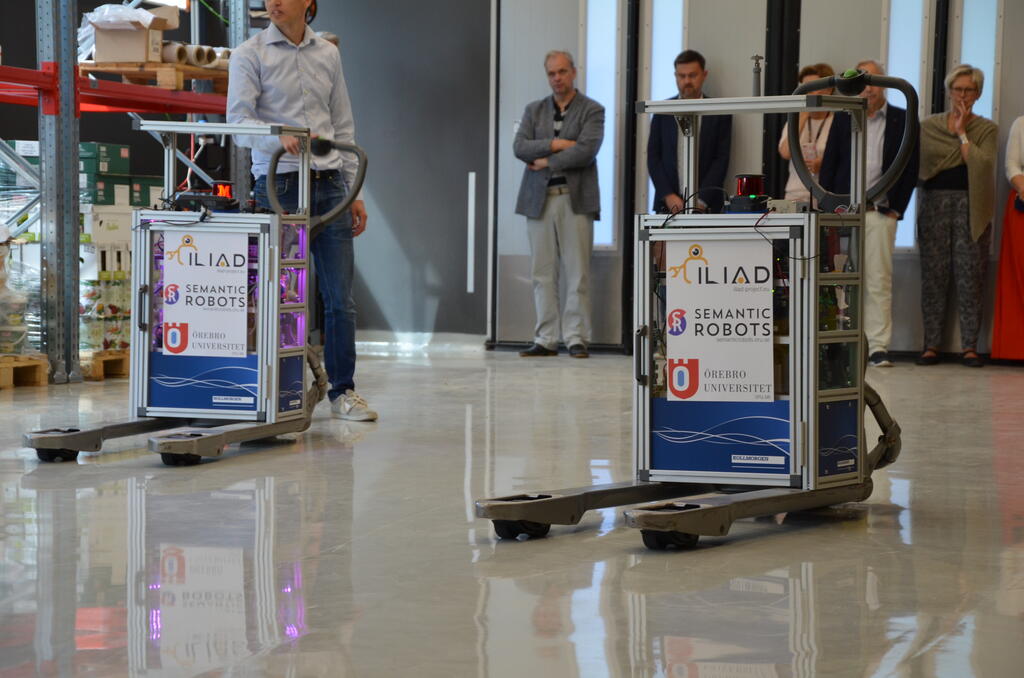How automatic material handling can increase Sweden’s competitiveness
Material handling will become safer and more cost-efficient through automation, which will increase Sweden’s competitiveness.At the same time, Region Örebro County is strengthening its role as a developer of smart logistics solutions.

These could be the effects of a broad study based in Region Örebro County, soon to be concluded, on how the efficiency of material handling in supply chains can be enhanced through automation.
Participants in the project are the forklift manufacturer Linde Material Handling; Scandfibre Logistics, part of the Billerud Group; the logistics company Logent; Örebro University and CLOSER/Lindholmen Science Park.
The starting point is that increasedautomation can make material handling both safer and more cost-efficient. This can be made by developing loading robots on self-driving and connected forklifts. The technology can be used, for example, in terminal transshipments between trucks and rail cars, or in moving freight to and from warehouses which creates a number of advantages:
- Costs can be reduced.
- Decreased risk for workplace injuries.
- Reduced risk of damages to cargo and machines.
- Lower energy consumption.
Digitalization, connectivity and automation of production and transportation is now regarded as a precondition for making efficient supply chains feasible. But despite major efforts being made, automation of the boundary between production and transportation remains relatively little researched.
The project Autolast, begun in December 2017, investigates the economic, organizational and technical conditions that need to be met in order to develop driverless forklifts that can load and unload trucks.
The project manager is Hannes Lindkvist at CLOSER, the national collaboration platform for increased transportation efficiency.
“The project illustrates how complex challenges, to an ever greater extent, require academia, the private sector and society to collaborate in order to create more efficient freight transport systems,” he says. “This contributes to increasing Swedish competitiveness. In addition, it means that Region Örebro County can play a clear role in the development of smart, efficient logistics designs and strengthen its position as a logistics hub.”
Logent, which runs a number of freight terminals around the country, sees the potential in automated solutions for loading and unloading of trailers, containers and rail cars to meet ever greater demands for efficient, automated flows around the clock, all year long.
“We see great potential in relatively smooth flows, for example, in productive operations where there are demands for continuity in the inflows and outflows so as to eliminate bottlenecks,” says Daniel Rhedin, Head of Consulting at Logent.
Scandfibre Logistics, which ships products for Billerud Korsnäs, takes the view that rail transport is facing a paradigm shift with digitalization and automation, in which driverless forklifts can improve the possibilities of transferring freight to rail.
“To benefit from this, we need a systemic perspective that looks at the entire transportation chain, including freight handling, in which driverless forklift systems in terminals and factory warehouses, for example, can reduce handling costs and expand the conditions for multimodal transportation,” says Pär Sund, head of logistics development at Scandfibre Logistics.
He adds that development toward a fossil fuel-free transportation system is created when the efficiency of the entire supply chain is enhanced and rail, forests and Swedish production become more competitive.
Martin Magnusson, lecturer at Örebro University, states that the current system for automation of warehouse logistics is hindered by insufficient flexibility as a result of, for example, predetermined routes and traffic rules:
“In addition, solutions for automation of the final moment in the logistics flow — loading from the warehouse into trucks or containers — is missing entirely,” he says. “Research issues we would like to tackle as part of the project include more flexible governance, where the robot “feels” where it is driving rather than driving toward fixed positions; self-teaching systems that require less work for installation and maintenance that instead teach themselves what the environment looks like and how the work is usually performed; and safe driving among people.”
Facts
• The project is a part of the innovation partnership program “The next generation’s travel and transport” and is funded in part by Vinnova, Sweden’s innovation agency, through Drive Sweden.
• Through this program, the Swedish Government designates five Swedish areas of strength in which, together with our partners, we invest in the future. These programs involve new ways of travelling, residing, doing business, living, communicating, and using and preserving the world’s resources and ecosystems.
• Sweden needs a more transport-efficient society, where transport is used in a smarter way and uses more resource-efficient vehicles. The innovation partnership program “The next generation’s travel and transport” includes all means of transport and has an overarching perspective in which all modes of transportation collaborate to provide solutions for travel by people and transportation of freight.
• The project is partly financed by Region Örebro County
Read more:
The government’s innovation partnership programs
The next generation’s travel and transport
For more information, please contact:
Hannes Lindkvist, Project Manager CLOSER/Lindholmen Science Park, hannes.lindkvist@lindholmen.se, +46 (0)730 288 285
